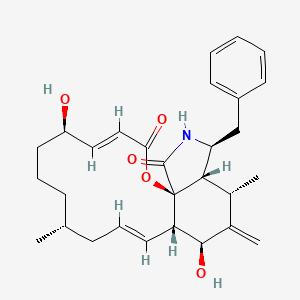| MeSH term | MeSH ID | Detail |
|---|---|---|
| Cell Transformation, Viral | D002472 | 26 associated lipids |
| Infectious Mononucleosis | D007244 | 5 associated lipids |
| Ataxia Telangiectasia | D001260 | 6 associated lipids |
| Pharyngeal Neoplasms | D010610 | 4 associated lipids |
| Coronavirus Infections | D018352 | 4 associated lipids |
| Chancroid | D002602 | 4 associated lipids |
| Trisomy | D014314 | 6 associated lipids |
| CREST Syndrome | D017675 | 2 associated lipids |
| Factor XII Deficiency | D005175 | 2 associated lipids |
CYTOCHALASIN B
CYTOCHALASIN B is a lipid of Polyketides (PK) class. Cytochalasin b is associated with abnormalities such as Renal tubular disorder and Chagas Disease. The involved functions are known as Membrane Protein Traffic, inhibitors, Metabolic Inhibition, Biochemical Pathway and Increased Sensitivy. Cytochalasin b often locates in Cytoplasmic matrix, Plasma membrane, Microtubules, Extracellular and Protoplasm. The associated genes with CYTOCHALASIN B are SLC2A2 gene, PFDN5 gene, SLC2A1 gene, OMG gene and SPEN gene. The related lipids are Steroids, Lipopolysaccharides and Liposomes. The related experimental models are Xenograft Model.
Cross Reference
Introduction
To understand associated biological information of CYTOCHALASIN B, we collected biological information of abnormalities, associated pathways, cellular/molecular locations, biological functions, related genes/proteins, lipids and common seen animal/experimental models with organized paragraphs from literatures.
What diseases are associated with CYTOCHALASIN B?
CYTOCHALASIN B is suspected in Renal tubular disorder, Chagas Disease and other diseases in descending order of the highest number of associated sentences.
Related references are mostly published in these journals:
| Disease | Cross reference | Weighted score | Related literature |
|---|
Possible diseases from mapped MeSH terms on references
We collected disease MeSH terms mapped to the references associated with CYTOCHALASIN B
PubChem Associated disorders and diseases
What pathways are associated with CYTOCHALASIN B
There are no associated biomedical information in the current reference collection.
PubChem Biomolecular Interactions and Pathways
Link to PubChem Biomolecular Interactions and PathwaysWhat cellular locations are associated with CYTOCHALASIN B?
Visualization in cellular structure
Associated locations are in red color. Not associated locations are in black.
Related references are published most in these journals:
| Location | Cross reference | Weighted score | Related literatures |
|---|
What functions are associated with CYTOCHALASIN B?
Related references are published most in these journals:
| Function | Cross reference | Weighted score | Related literatures |
|---|
What lipids are associated with CYTOCHALASIN B?
Related references are published most in these journals:
| Lipid concept | Cross reference | Weighted score | Related literatures |
|---|
What genes are associated with CYTOCHALASIN B?
Related references are published most in these journals:
| Gene | Cross reference | Weighted score | Related literatures |
|---|
What common seen animal models are associated with CYTOCHALASIN B?
Xenograft Model
Xenograft Model are used in the study 'Endofacial competitive inhibition of the glucose transporter 1 activity by gossypol.' (Pérez A et al., 2009).
Related references are published most in these journals:
| Model | Cross reference | Weighted score | Related literatures |
|---|
NCBI Entrez Crosslinks
All references with CYTOCHALASIN B
Download all related citations| Authors | Title | Published | Journal | PubMed Link |
|---|---|---|---|---|
| Saranko CJ and Recio L | The butadiene metabolite, 1,2:3,4-diepoxybutane, induces micronuclei but is only weakly mutagenic at lacI in the Big Blue Rat2 lacI transgenic cell line. | 1998 | Environ. Mol. Mutagen. | pmid:9464313 |
| White JG and Rao GH | Microtubule coils versus the surface membrane cytoskeleton in maintenance and restoration of platelet discoid shape. | 1998 | Am. J. Pathol. | pmid:9466587 |
| Pawlowski P et al. | Bioelectrorheological model of the cell. 7. Cellular deformation in the presence of cytochalasin B. | 1997 May-Jun | Biorheology | pmid:9474262 |
| Waki A et al. | Glucose transporter protein-independent tumor cell accumulation of fluorine-18-AFDG, a lipophilic fluorine-18-FDG analog. | 1998 | J. Nucl. Med. | pmid:9476929 |
| Lee E et al. | Formation of F-actin aggregates in cells treated with actin stabilizing drugs. | 1998 | Cell Motil. Cytoskeleton | pmid:9484954 |
| Schapiro FB et al. | pH-independent retrograde targeting of glycolipids to the Golgi complex. | 1998 | Am. J. Physiol. | pmid:9486120 |
| Koumanov F et al. | Cell-surface biotinylation of GLUT4 using bis-mannose photolabels. | 1998 | Biochem. J. | pmid:9494087 |
| Masunaga S et al. | Responses of total and quiescent cell populations in solid tumors to boron and gadolinium neutron capture reaction using neutrons with two different energy spectra. | 1998 | Jpn. J. Cancer Res. | pmid:9510480 |
| Qiu C et al. | Cationic liposomes enhance adenovirus entry via a pathway independent of the fiber receptor and alpha(v)-integrins. | 1998 | Hum. Gene Ther. | pmid:9525312 |
| Sauer H et al. | Hypotonic Ca2+ signaling and volume regulation in proliferating and quiescent cells from multicellular spheroids. | 1998 | J. Cell. Physiol. | pmid:9525471 |
